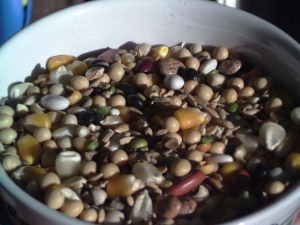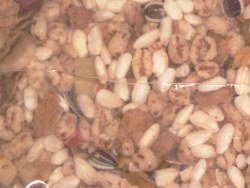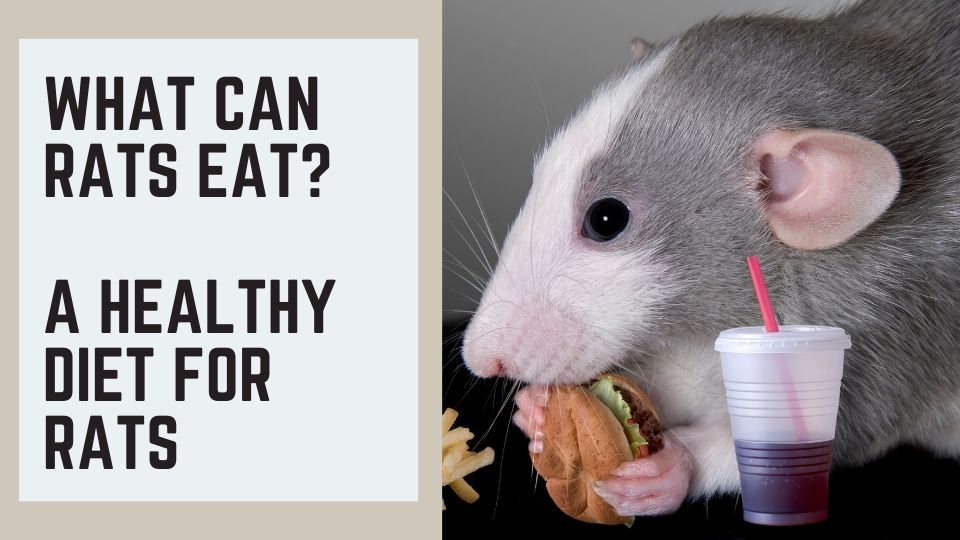Anyone that knows me, knows I am a proponent of raw food. My dogs eat it, my cats eat it, why wouldn’t my rats eat it. How do you feed raw to a rat?
Healthy Diet for Rats
The concept of raw food is easy- you just try to mimic the natural diet of an individual species by using foods that are fresh and minimally cooked. What does that mean for a rat?
Well, first of all, variety is the spice of life. Not only that, but variety is the most important part of a healthy diet. Just like your doctor told you, eat a variety of fresh, whole foods- and that is a healthy diet. So here’s what I feed my rats-
First -lots of fresh clean filtered water.
Don’t use that stuff from the tap. It’s full of chlorine and chloramines. These chemicals build up in a tiny rat body pretty quickly and can prove deadly.
I use a faucet filter, but a Britta pitcher or bottled water will work just as well. just make sure it is available to them at all times.
Now Is the time to start thinking about fresh foods. my rats’ diet consists of approximately-
40% fresh organic vegetables
10% fresh organic fruit
30% lightly cooked grains and legumes
10% organic meat
2% nuts in shell
5% prepared diet
and 3% incidentals
Vegetables
this is what my rats’ dinner typically looks like. Go crazy at the store. buy the things you would never eat. just give them a try. just remember to avoid the products on the “forbidden foods list” in the side column.
on any given day, my rats’ bowls will contain- zucchini, cauliflower, carrots, winter squash, watercress, mint, parsley, baby greens, kale, collard greens, tomatillos, bell peppers, jicama-
the list goes on. remember- variety is what’s important here.

rats, like children, will pick out what they like most, and ignore the things they don’t. I have a rat that will dig through the bowl snatching up any hint of cauliflower. meanwhile, her sister, on the other side of the bowl, is filling herself up with baby greens.
how do I circumvent this problem? I don’t offer cauliflower two days in a row! I try not to offer any veggies more than twice a week. that leaves my cauliflower-loving lady forced to eat tomatoes and squash. offering a different variety on a daily basis achieves balance.
Fruits
I like to make about 10% of my rats’ diet fresh fruit. these can be anything like apples, plums, raspberries, melons, strawberries, bananas. if you give them apples, plums, or peaches, be sure to remove the seeds and pits.
Remember, don’t give oranges or orange juice to male rats, it causes prostate problems. be sure to check the “forbidden foods list” to see what should be avoided.
Grains and Legumes
30% of my rats’ diet consists of lightly cooked grains and beans.
I use a product called “soak and simmer” by Volkman. it contains a number of different grains and beans.
including soybeans, paddy rice, green peas, pearl barley, groats, lentils, limas- and a whole lot more. they are all human-grade ingredients.

It is easy to prepare, just add water and simmer! they love it. never feed uncooked beans.
Meat
10% of the diet consists of meat and meat products. Did you cook chicken breast for dinner? Share a little with the rats! how about meatballs? same thing.
I like to use a product by Wysong that is a canned meat-only product. it comes in venison, chicken, duck, beef, and rabbit. it makes for a simple quick fix if I didn’t cook meat for dinner.
But…don’t get caught into thinking that “meat” is only the kinds of things you will eat… there’s more to “meat” than that! eggs, tofu sardines, canned oysters, and bugs!! yes, bugs. mealworms, super worms, grasshoppers, and crickets.
the more alive, the better. if your rat is unfamiliar with live bugs, you will want to start them out on canned bugs. once they get a taste for crickets– they are more than willing to hunt them.
check back soon for information regarding my “hunter’s ranch”, a special cage for live cricket hunting. if you are feeding worms for the first time- start with mealworms. they are slow-moving, and they don’t bite.
once they learn how to quickly dispatch a live mealworm, get those super worms!!! they go crazy for them.
Just remember–never give a rat an insect you caught yourself- wild bugs carry parasites and may have been exposed to pesticides.
nuts in the shell
2% of the diet consists of nuts in the shell. these are mainly for entertainment value.
The rats really enjoy all the hard work it takes to get the nut out of the shell. it’s kind of like a kong for rats.

prepared diet
5% is a prepared diet. I use a variation of suebee’s rat diet.
it is easy to make, and most of the ingredients can be bought at your local grocery store.
of course, I am an advocate of variety, so I change the ingredients just a little bit every time I make it.

before you decide this is way too hard, or before you get out your calculator- don’t worry! it’s not that hard. just apply some common sense. if common sense fails you, try this- take a one-cup measuring cup and do the following:
- fill it a little less than halfway with chopped veggies (40%)
- then up to the halfway mark with chopped fruits
- (10%)
- add about 3 tablespoons of grains and legumes
- (30%)
- 1 tablespoon of meats
- (10%)
- 2 teaspoons of prepared diet
- one nut in the shell and about 4 lab blocks
- there you have it! it’s that easy.
don't skimp on the veggies and fruits, remember they contain a lot of fiber and water, so rats need to eat more of them than a dry diet. the lab blocks will most likely be set aside for a nice midmorning snack, that way they will always have something to munch on.
all of this can change back and forth. some days my rats get only veggies, other days only grains. some times they get a mixture of everything, or sometimes just some scrambled eggs.
mix it up, be creative. remember, you want variety – not science! you are allowed to do some guessing.
this diet keeps my rats happy and healthy. and they don’t get bored with the same old thing day after day.
if you have any questions- send me an e-mail, I’ll be glad to answer them.
Why Rats?
Thor, good to the last drop! When considering a pet to join your household, please consider a fancy rat.
They are small and quiet, take up very little space, and don’t cost much to own. Rats don’t need licensing or vaccinations, like other common pets.
You can keep them just about anywhere since most landlords will accept small caged animals.
They even make great dorm pets. So if there’s room for a cage, there’s room for a rat! Rats make wonderful pets for homes with children, providing endless enjoyment with their hysterical antics. They are a joy to have around, just be sure to keep an eye on your glasses!
Flora hops on Skyeler’s glasses!
Rats are fairly inexpensive pets. A pair of rats will cost you between $5 and $30 to adopt, depending on where you get them.
A suitable cage can be found for $30-$90 (much less if you check thrift stores, garage sales, or the classifieds). You can also build your own cage.
To see if a cage is big enough for rats, try this cage calculator. Bedding, rat food, water bottle, food dish, and toys will be around $20.
So for approximately $75 you can have two wonderful pets that will provide you endless amounts of love and cuddles.
Tips To Get You Started!
Echo loves ice cubes!
Rats are extremely social creatures. You should always buy them in same-sex pairs (or more) so that they can groom each other and keep each other company late at night when you are not available to play.
It is important to keep their cage in the area of the home that you are in most (i.e. family room, home office). That way even if you can’t play, they can still see what is going on and feel like a part of the family.
There are many places you can buy or adopt rats. A few options are Animal Shelters, Pet Stores, and Breeders.
In Summary
If you have any more questions about owning pet rats, please e-mail us. We are always available to help answer questions and have many resources to provide you.




